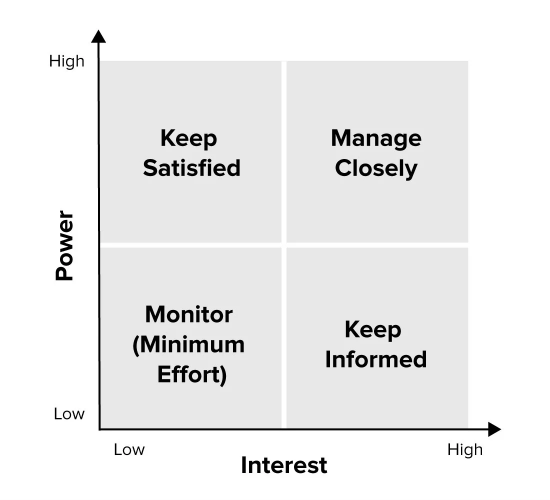
The foundation of successful marketing requires a complete understanding of the audiences and industry sectors companies serve. By developing deep insight and knowledge, marketers address pain points, propose solutions and communicate effectively with prospects and customers. Accomplishing this goal, however, can be a daunting task. Where do you begin? One place to start is with a stakeholder analysis.
What is a Stakeholder Analysis?
One tool used frequently in project management is a stakeholder analysis. According to Larry Smith with the Project Management Institute, “Stakeholder analysis typically refers to the range of techniques or tools to identify and understand the needs and expectations of major interests inside and outside the project environment. Understanding the attributes, interrelationships, interfaces among and between project advocates and opponents assists us in strategically planning our project.” Use this information to assess how the interests of those stakeholders should be addressed in a project plan, policy, program or other action. In simpler terms, a stakeholder analysis is a process that helps you identify, prioritize, understand and meet the needs of your stakeholders or the various entities your work affects.
The approach is easily transferable to marketing. A stakeholder analysis helps marketers and salespeople understand the individuals and groups affected by an issue. Typically, the issue represents the need for your products or services. This analysis facilitates identifying those most affected by the purchase and use, those indirectly affected and those least affected. Consider these groups as primary, secondary and tertiary stakeholders. From there, your goal is to 1) understand what motivates a stakeholder or group of stakeholders; 2) determine what other priorities they have; 3) identify how to align your product and/or services with their needs in mind; and 4) uncover how a stakeholder is likely to perceive your company and its value proposition.
Stakeholder Mapping Through a Power/Interest Grid
A stakeholder map is an approachable and systematic way to help define stakeholders and discover who the primary stakeholders are. There are multiple ways to create stakeholder maps. The most commonly used is the power/interest grid. The map plots individuals and parties into four groups. These groups are based on perceived interest and power regarding a prospect or client’s pain point your company will address.
The first step in using the power/interest grid is to brainstorm who the stakeholders are. Think of all the people your project, product or service affects. Include those who have influence or power over it or have an interest in its successful or unsuccessful conclusion. Then create a list. Once the stakeholders are identified, place them into the appropriate category on the power/interest grid. This assists you in determining which stakeholders need to be focused on and the actions to take.

- High Power/High Interest
This group includes the decision-makers and consists of most of your primary stakeholders. Decision-makers require consistent engagement, collaboration and communication. They need to know the details as well as the big picture. They’re the ones who will say ‘yes’ or ‘no’ to working with you. They also are often the departments or individuals within a client company that you work closely with on a project. Keep them in mind for almost all marketing communications related to their pain points.
- High Power/Low Interest
This group also can be referred to as the “context setters” or “referees.” According to product management expert Roman Pilcher, “they affect the product’s context, but they take little interest in the product itself. An example is the person in charge of the development group: If the individual does not help staff the development team properly, then the success of the product may be at risk.” In that example, the staffer sets the context, but may not be as closely tied to implementing solutions. This group can have a lot of influence over the project but doesn’t necessarily want or need to be involved in the details. They require less consistent communication, but still want to be kept up to date on progress. They require a grasp of the big picture.
- Low Power/High Interest
This group also is referred to as “the subjects.” Subjects don’t have much power, but this doesn’t mean they are any less important. They are highly affected by a pain point and are keen to solve it. Yet they aren’t in charge of the decision-making. That said, they are just as important to understand and communicate with as the decision-makers since they are likely to weigh in about using your products or services. It is often the decision makers’ job to understand the needs of the subjects and to filter which of their needs becomes a priority. As a marketer, understanding your subjects gives you a leg up in connecting and communicating effectively.
- Low Power/Low Interest
Finally, the involved parties with the least power and interest may not be as important to your strategic communications, but still need to be understood. This group might consist of entry-level employees, interns or a company’s outside vendors. They do not have decision-making power and have little stake in the pain point but are still significant cogs in the system. You may not need to address this group in your outreach, but understanding their role helps you see the big picture.
Creating Solutions

By framing your products and services as a solution to a problem, you can understand and address the numerous stakeholders involved. Choosing a business partner requires participation, guidance, and approval from a wide range of individuals across an organization. If they don’t understand or agree with the objectives, any of these company stakeholders can become obstacles as opposed to supporters. Use a stakeholder analysis to identify all potential stakeholders and determine how best to earn their trust and support.
